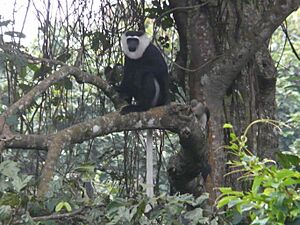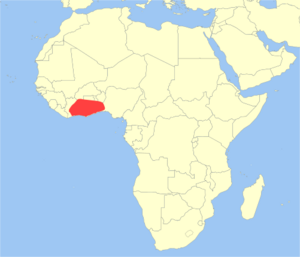White-thighed colobus facts for kids
Quick facts for kids Ursine colobus |
|
|---|---|
 |
|
| Conservation status | |
| Scientific classification | |
| Genus: |
Colobus
|
| Species: |
vellerosus
|
 |
|
| Geographic range | |
The ursine colobus (Colobus vellerosus), also known as the white-thighed colobus, is a cool type of monkey. It lives in West Africa and belongs to a family of primates called Cercopithecidae. These monkeys are known for their unique looks and how they live in the forest.
Contents
What Does the Ursine Colobus Look Like?
The ursine colobus is easy to spot! Most of its fur is black. It doesn't have a white "cape" like some other colobus monkeys. Its face is black and bare, but a thick ring of white fur surrounds it.
You can also tell them apart by the white patches on their thighs. These patches can be different widths and lengths. Baby ursine colobuses are born with all-white fur. This fur starts to turn black when they are about three months old.
Unlike some other colobus species, they have slim bodies. They also have special tough skin on their bottoms called ischial callosities. This helps them sit comfortably on tree branches for a long time. Their tail is completely white and is even longer than their body!
Male ursine colobuses usually weigh between 9.9 and 10.3 kilograms (about 22 to 23 pounds). Females are a bit lighter, weighing 8.3 to 8.7 kilograms (about 18 to 19 pounds). Their bodies are about 61 to 66 centimeters (24 to 26 inches) long.
How Do Ursine Colobuses Live?
Ursine colobuses are active during the day. They spend almost all their time high up in the trees. They only come down to the ground sometimes, usually when they are looking for food.
Family Life
These monkeys live in groups, much like many other monkeys. Each group usually has several related females and their young. There is also one male who protects their territory. When young males grow up, they leave their birth group to find a new one.
Talking Like a Colobus
Ursine colobuses use loud calls to show where their territory is. They also use these calls to let others know where they are. Their special roar is a low "rur, rur, rur" sound.
They also have alarm calls to warn their group about predators. When they see danger, all the monkeys (except the babies) make a "snorting" sound. This tells everyone to be careful!
What Do They Eat?
Ursine colobuses are mostly vegetarians. Their diet mainly consists of fresh leaves and seeds. Sometimes, they also eat fruits, insects, and even special termite clay.
Where Do They Live?
You can find ursine colobuses in lowland rainforests. They also live in "gallery forests." These are forests that grow along rivers and stretch north into the Guinea Forest Savannah Zone.
For example, in Bénin, these monkeys have been seen in different types of forests. This includes swamp forests, semi-deciduous forests, and gallery forests.
Where Can You Find Them?
The ursine colobus lives in several countries in West Africa. These include Benin, Ivory Coast, Ghana, Nigeria, and Togo. You might also find them in the very southernmost part of Burkina Faso. Their natural home is in warm, wet lowland forests.
Sadly, their homes are shrinking because of habitat loss.
Protecting the Ursine Colobus
The ursine colobus faces two big threats: hunting and forests being cut down. They live in an area where many people live, and the population is growing fast. This means a lot of forests are being destroyed. Also, hunting of wild animals is not always controlled in many places.
However, in some parts of their home, these monkeys are considered special or sacred. This helps protect them. The ursine colobus is listed under Class A of the African Convention. It is also in Appendix II of CITES, which helps control trade of endangered species.
Good news! These monkeys live in several protected areas. These include Comoe National Park, Fazao-Malfakassa National Park, and Mole, Bui, and Digya National Parks in Ghana. These parks help keep them safe.


